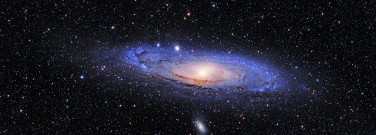Uncovering Dark Matter Mysteries

By Kylie Wolfe
Dark matter is a mystery all its own. It can’t be seen, but it makes up 80 percent of the universe. It’s hard to study, but scientists know it exists and have observed its effects.
An international research team recently created a map of dark matter and discovered filament-like connections between galaxies. Their findings were published in The Astrophysical Journal and offer insights to the distribution of dark matter.
A New Approach
The group, mostly consisting of astrophysicists based in Korea, used machine learning to produce a more detailed map of the local universe. Other attempts weren’t as insightful because they used models of the early universe to simulate present day. With more advanced technology, the team was able to incorporate more galaxies and predict dark matter distribution.
“Ironically, it's easier to study the distribution of dark matter much further away because it reflects the very distant past, which is much less complex," Donghui Jeong told Science Daily. Jeong, an associate professor of astronomy and astrophysics at Penn State University, also contributed to the study.
To build and train their model, the team used Illustris-TNG, a project simulating galaxies and other matter. Then, they added data from the Cosmicflows-3 catalog, a collection of information about thousands of galaxies.
"When given certain information, the model can essentially fill in the gaps based on what it has looked at before," said Jeong. They included the motion and distribution of each galaxy to help improve the map’s quality.
Understanding the Universe
What differentiates this map from previous renderings, other than the method in which it was made, is that it gives scientists a closer look at the local universe. It shows known structures in addition to new ones, including filament-like connections between galaxies, that require more research.
These results will help scientists study the distribution of dark matter, its nature, and what remains unknown. For example, it’s believed that the Milky Way and Andromeda galaxies are creeping toward each other. Further research, especially into the dark matter filaments discovered during this study, will help determine how likely it is for the two to collide one day.
"Because dark matter dominates the dynamics of the universe, it basically determines our fate," Jeong concluded.
The team hopes to add smaller and more distant galaxies to the mix, improving the accuracy of their map. Other researchers can also apply these findings to their understanding of dark matter, helping them explain the history and future of our universe.
Discussion Questions
- What makes this map more detailed than others? How did the researchers accomplish this?
- How does this study increase your understanding of dark matter?
Vocabulary
- Astrophysicist
- Dark matter
- Galaxy